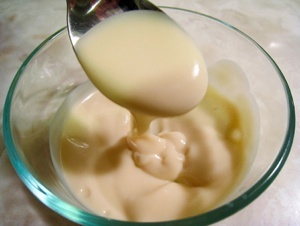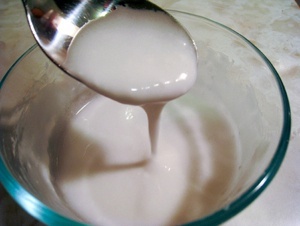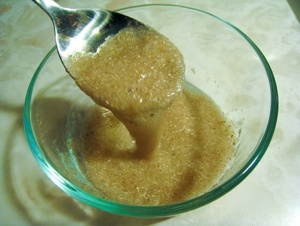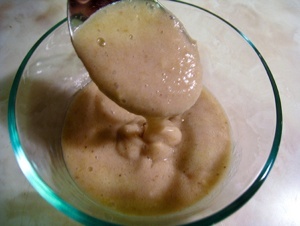Veganbaking.net
Vegan Baking Recipes
Vegan Egg Replacer Recipes
Flax Seed Egg Replacer - An Egg Substitute That's Almost Magic
Flax Seed Egg Replacer - An Egg Substitute That's Almost Magic
18
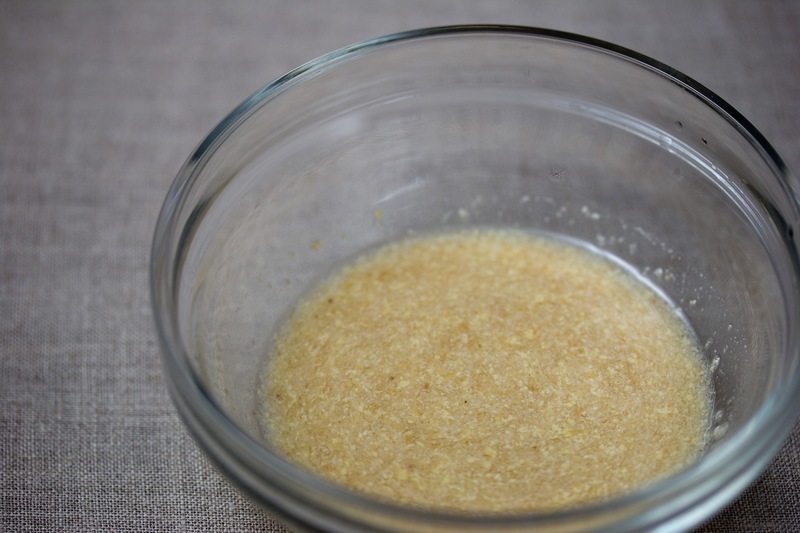
Traditional bakers have been able to create a vast variety of foods over the last several hundred years of baking evolution. It’s surprising when you realize that everything from puddings to cakes to cookies vary little in the range of ingredients used. Versatile ingredients such as flour, sugar, fat and eggs make this sort of variation possible. These are the building blocks of pastry. Vegan baking is easy when all you have to worry about is manipulating flour, sugar and fat. So what are we do to do in regards to replacing the almighty egg? There is a legend that the Romans believed in chicken eggs so much, they mixed them into their concrete. To first understand what we need to replicate this building block we need to understand what an egg does in the world of baking.
Understanding the Egg
Love them or hate them, the chicken egg is an extremely useful food. If they were discovered today, they would trigger a revolution in how food is prepared. Eggs work in the following ways in traditional baking applications:
Structure builder
Eggs contain a particularly useful protein, among other egg proteins, called ovalbumin that is found in the translucent white, or albumen. These and other proteins consist in their natural state on the microscopic level as little rolled up balls. Think of them as tiny balls of yarn. When this protein is exposed to heat, it denatures or distorts it which causes them to unfold into little protein strands. The strands then join together to form a strong protein network that gives foods structure. This structure gets stiffer and stronger and actually pulls together slightly as more heat is applied and water is driven off. I visualize this as how rebar strengthens concrete. This network reinforcement is similar to how glutenin and gliadin come together to form a gluten network that creates structure in wheat-based bread. Ingredients that give foods this property are known as structure builders. This is why it is possible to have cake-like consistency in traditional flourless cakes; the eggs provide most of the structure in the absence of flour and actually work just like it.
Foaming agent
This is somewhat similar to structure building in that the egg proteins are not only good at strengthening, but also trapping air bubbles. Egg proteins and many other types of proteins can be denatured by heat but also by friction such as kneading or whipping. In this case, the egg proteins are denatured by whipping, join together and trap air bubbles. This is why eggs foams work so well in leavening cakes.
Emulsifier
An emulsifier is any molecule that has a water loving, or hygroscopic side and an oil loving, and hence, water repelling or hydrophobic opposite side. Emulsifiers are used in food to mix oil and water. This allows fats to more easily be dispersed in a food and water to be held in the food longer, leading to softer textures that take longer to stale. It is this ability of oil and water to work together that enables smooth ice creams, supple cakes and soft and chewy cookies.
There is no one type of food that can replicate all of these properties like an egg can so when looking into egg substitutions we need to use the ones that work for what we’re specifically trying to accomplish in the food. Flax seeds tend to be one of the most versatile foods for replacing eggs.
Flax Egg Replacer
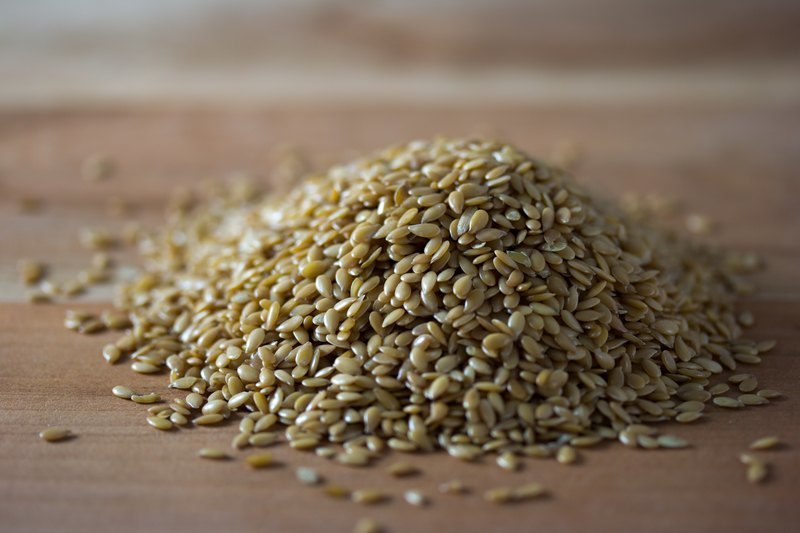
Flax seeds have an outer hull consisting of five layers. The outermost layer, called the epiderm, contains a mucilaginous material which makes up about 8% of the flax seed by weight. This goopy material, known in the food science world as a mucilage, or gel, can be drawn out of the seed in several ways and used as an egg replacement that is suitable for many vegan baking applications. Flax gel is a hydrocolloid, which is defined as a substance that forms a gel when combined with water. The term comes from hydro, meaning water, and colloid, meaning a substance microscopically dispersed throughout another substance. The hydrocolloid family is huge, with vegan variants including foods such as tapioca starch, corn starch, potato starch, arrowroot starch, agar, carrageenan and even lesser known ones with weirder sounding names such as xanthan gum, guar gum and sodium alginate. It seems almost as if there is a law somewhere that states that many hydrocolloids need to have names that sound like scary alien rulers. Fear not, because most of the time, these wonder ingredients are made up of basic food building blocks known as polysaccharides. Hydrocolloids usually work either build structure, emulsify and soften mouthfeel; many things that eggs already do in traditional baking applications.
Flax gel is made up of mainly polysaccharides which is a type of starch. Polysaccharides, from the words many sugars, consist of continuous strings of monosaccharides, or single sugars; individual sugar molecules such as glucose, fructose, or other sugar molecules. Make a necklace out of a dozen or so Fruit Loops cereal rings. Now open that necklace end-to-end and lay it out in a straight line on a table. What you have now is a model of a polysaccharide where the Fruit Loops rings are the monosaccharide molecules. Polysaccharides are important in foods because they are exceptional at holding onto water molecules. Their long sugar strings also bump and tangle into each other when poured which causes them to increase the viscosity of water-based fluids. To illustrate this, visualize pouring a cup of rice compared to pouring a cup of water. Water pours easily because water molecules are tiny and slide past each other with minimal friction. Rice grains are larger and have more surface friction so they don't pour as fluidly. Polysaccharides are also responsible for the thickness of molasses and why brown sugar retains more water to make for chewier cookies. Molasses also contains smaller sugar molecules that fit into the flavor receptors on our tongue and are perceived as sweet. Polysaccharides are too large to fit into these flavor receptors so their flavor is not significantly sensed on the palette.
Other plants such as chia seeds, aloe vera, okra and even some basil seeds also contain polysaccharide gels. I have experimented with okra and chia and found that chia seeds can be substituted for flax seeds on a roughly one to one basis, although they are considerably more expensive. I found okra gel to lack suitable density to be superior to flax and chia gels.
Other plants such as chia seeds, aloe vera, okra and even some basil seeds also contain polysaccharide gels. I have experimented with okra and chia and found that chia seeds can be substituted for flax seeds on a roughly one to one basis, although they are considerably more expensive. I found okra gel to lack suitable density to be superior to flax and chia gels.
Plants use polysaccharides as food by breaking them down into their individual sugars and metabolizing them into energy. This is especially important to the flax plant because its seed will use these polysaccharides during the sprouting phase. Since they’re made up of sugars which are water loving or hygroscopic, they are especially good at holding onto water for the plant to use as well.
Fortunately for us, many of the reasons polysaccharides are useful for plants are the same reasons they work great for egg substitutes. Flax gel can work as a mild structure builder, low foaming agent and emulsifier in vegan baking applications. Most other vegan egg replacers such as fruit purées, legume flours and non-dairy yogurts can only do one or two of these things. Flax gel is able to do all three without imparting off flavors, colors or textures when it is done properly. Depending on how flax egg replacers are prepared, they can be a healthy alternative to other egg replacers due to their excellent source of omega-3 fatty acids and protein content.
Flax Seed Drawbacks
Like most other egg replacers, flax seeds are never going to perform exactly like eggs. Eggs rely on proteins to do most of their work and flax seeds use polysaccharides so the results will not be exactly the same. Flax seed egg replacer is not a terrific foaming agent. That means it's next to impossible to use it to make extremely airy desserts like angel food cake, choux pastry or popovers. In fact, flax seed egg replacer can even do more harm than good in cakes due to its tendency to hold onto excess moisture. It also is not a structure builder in that it won’t form protein networks that reinforce doughs like an egg will. It will work to stick things together instead.
Finding the right Flax Seeds
When using flax for any food application it’s important to keep in mind two crucial points:
- Never buy pre-ground flax seeds. Flax seeds contain oils that are extremely perishable. When the flax seed is ground, the oil is exposed to oxygen and begins to oxidize almost immediately. This oxidization turns the oils rancid which makes them toxic and causes them to impart a linseed oil aroma and flavor to your food. Linseed oil is in fact oxidized flax oil. When you buy pre-ground flax seeds there’s no way to tell how long they’ve been sitting around oxidizing. Always buy flax seeds whole, grind them yourself with a coffee grinder if you’re using them ground and store them in an airtight container in your freezer where they will keep for about a year. If you detect the taste of linseed oil in food prepared with flax seed egg replacers, this means that the flax seeds have gone rancid and should be discarded.
- Look for golden flax seeds instead of brown.The brown variety will be more likely to darken your baked goods due their brown hulls.
Using Flax as an Egg Substitute
There are two ways to use flax seed as a vegan egg replacer. One is to use the whole ground flax meal dispersed in a liquid such as water, non-dairy milk or fruit juice and use it after it forms into a gel. The other, more involved way to use flax seed as an egg substitute is to boil whole flax seeds with water which extracts the gel, strain the flax gel off then discard the flax seeds. Each method has its benefits and drawbacks. Both methods are illustrated below.
Flax Meal Egg Replacer Recipe
In this method, golden flax seeds are ground into a whole flax meal with a coffee grinder. This flax meal is then mixed into a slurry with water and allowed to sit until a gel forms. This slurry, as well as the gel that accompanies it is used to replace the egg. I use the same grinder for my coffee as I do for my flax grinding. To ensure my flax meal doesn’t take on coffee flavors, I first grind a small amount of either corn flour, dried rice or flax seeds and discard it. This first grind will remove all of the coffee flavor so you can grind flax seeds without having them absorb coffee flavors or aromas.


Pros of this method
- It’s fast and works great for most egg substitutions where eggs are used, such as in baking applications where moistness and denseness are desired qualities.
- If you bake rarely you can pre-grind a large quantity of flax seeds, store them in your freezer and only use what you need when you need it.
Cons of this method
- Flax meal has a subtle mealy flavor that's usually not prominent enough to stand out in most baked items as long as you don't add any more than about 3 Tablespoons of flax meal per normal, family-sized recipe.
- Flax meal can work as the opposite as a structure builder in cakes because its slippery nature holds onto moisture. The mucilage can actually coat the gluten and gliadin, effectively blocking gluten bonds from forming. So I recommend against using it in cakes. I admit, it took me a while to figure this one out!
- This method won’t work when a smooth, creamy texture or a uniform light color is desired; the flax seed particles will make soft ingredients such as frostings and sauces grainy and light colored baked items will have golden flecks.
This recipe makes the equivalent of 1 egg.
3 Tablespoons water
1 Tablespoon golden flax meal
1) Grind your flax seeds
Grind the golden flax seeds into a meal in a blender or spice grinder. You may want to grind a larger amount and store it for future use. Like flax oil, flax seeds are extremely perishable so if you grind a larger amount for later use, store it in an airtight container in the freezer for up to one year. 1 cup of golden flax seeds equals about 1 ⅓ cup of flax meal.
2) Whisk water into your flax seed meal
Add the water to a small bowl or cup. Add the flax meal and mix together with a whisk or fork. Let the mixture sit for about 10 minutes so it develops a gelatinous texture similar to a raw egg. Warm water will speed up this gelling process and make it happen about twice as fast.
Flax Gel Egg Replacer Recipe
This method involves extracting the flax gel from whole flax seeds using hot water then discarding the flax seeds. The gel is used to replace the egg. I must give credit to Miyoko Schinner for possibly inventing this method and popularizing it in her teachings.
Want to use flax gel in an already vegan recipe for extra binding power or to swap out another egg replacer? In this case, substitute the flax gel for the water in the recipe and whisk it in with the water-based ingredients. For instance, if your vegan recipe calls for 1 cup non-dairy milk, use ¾ cups + 1 Tablespoon non-dairy milk (1 cup minus 3 Tablespoons) and 3 Tablespoons (45 mL) flax gel to replace one egg equivalent and whisk them together. It’s ok if there are some other ingredients included when you whisk them together but since flax gel is water based, it will disperse best in water based liquids as you’re progressing through your recipe. Whisking flax gel into the vegetable oil in your recipe will not work because it won't allow the flax gel to disperse into the ingredients so it can do its job.
Pros of this method
- Since there are no particles in the flax gel and it is translucent, it performs much more like an actual egg. It won’t impart as much flax flavor, color will not be affected and it won't contribute to a mealy texture. The purity of this flax gel allows you to use more of it where you need extra binding or emulsifying power such as soft and chewy cookies, bars or even ice creams.
- Preparing flax gel allows you to make it in large quantities which can be a benefit if you bake often.
Cons of this method
- This method is far more involved than the Flax Meal Egg Replacer. If you don’t bake often it may be more trouble than it’s worth.
- It can be tricky to measure flax gel due to its high viscosity and elasticity, but a solution is below.
- Once you make flax gel, its life is limited to about 1 week in your refrigerator or up to 3 months in your freezer where it will have to be thawed out before each use. You can make this convenient by measuring out small quantities into an ice cube tray, placing it in a plastic freezer bag and freezing it.
3 Tablespoons (45 mL) Flax Gel equals 1 egg.
3 cups water
3 cups water
5 Tablespoons (50 grams) flax seeds
1) Boil the flax seeds in water
In a small saucepan, add the water and flax seeds. Bring the mixture to a boil, uncovered, over medium-high heat. Reduce heat to a low boil, stirring occasionally, until the mixture is gelatinous and stringy, about 20 to 25 minutes. It’s important that the mixture is boiled uncovered here because not only are we coaxing the polysaccharides out of the husk of the flax seed with heat, we’re also boiling off some of the water to get an extra thick consistency.
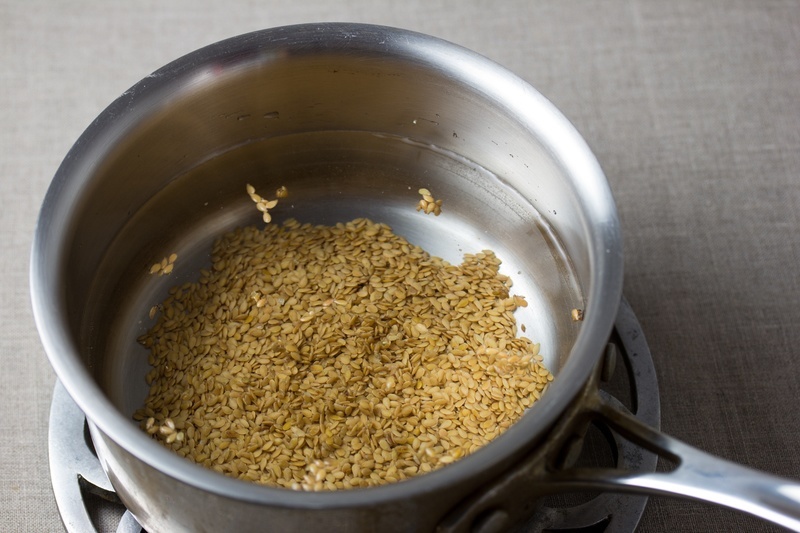
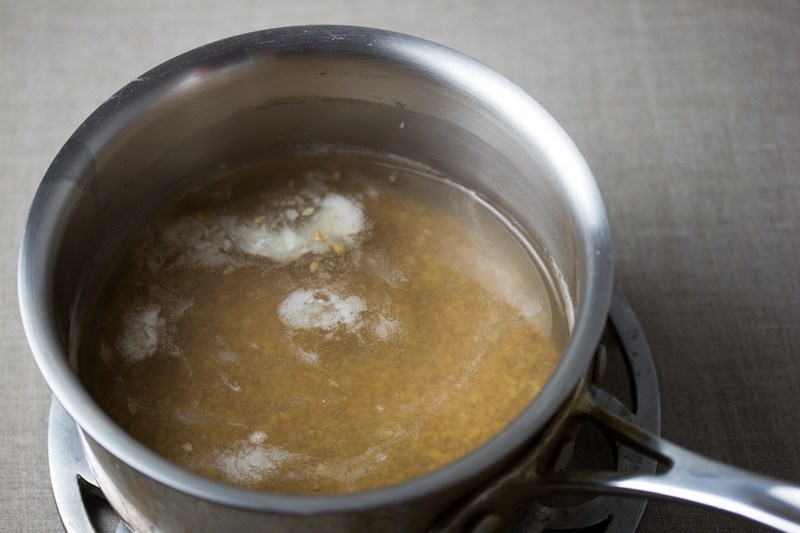


2) Strain off the flax seed mucilage
It’s extremely important to use a strainer that has holes small enough so that the flax seeds don’t fall through but not too small or the flax gel won't drain off. This is the colander I recommend. A cheesecloth will not work because the flax gel won’t be able to flow through it. Immediately after boiling, place the strainer inside of a bowl and pour the mixture into the strainer. Wiping back and forth along the mesh of the strainer with a spatula can accelerate the straining process. It’s important that you strain the mixture immediately after boiling because as soon as it cools it will thicken to the point of where it's too thick to strain. If this happens, you can always reheat the mixture to a boil then strain it. Discard the flax seeds.
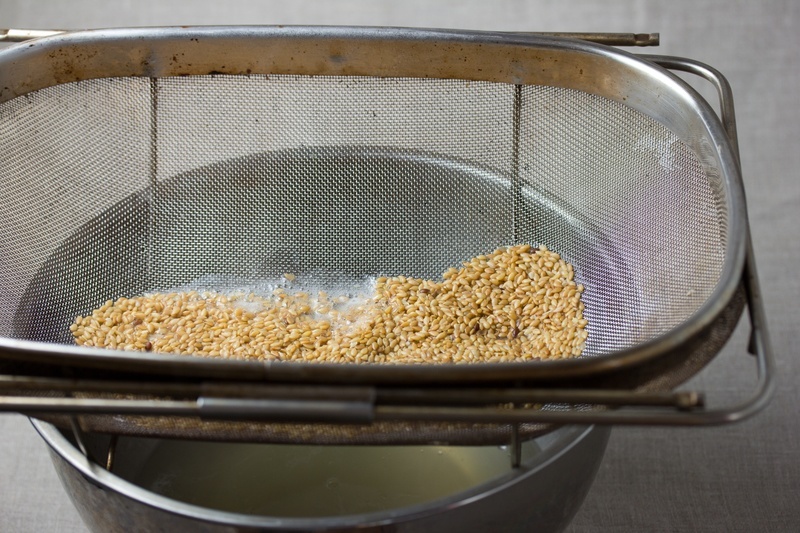

3) Allow the flax mucilage to cool
Transfer the mixture to a small container and allow it to cool in the refrigerator until room temperature, about 1 hour. If using later, store it in the refrigerator in an airtight container for up to 1 week or in the freezer for up to 3 months. If you’re freezing the mixture you should consider measuring out 3 Tablespoon quantities, placing them in an ice cube tray and placing the tray in a plastic freezer bag before freezing. That way you can easily use one egg of flax gel without the burden of preparing it every time. Makes about 1 cup flax gel.
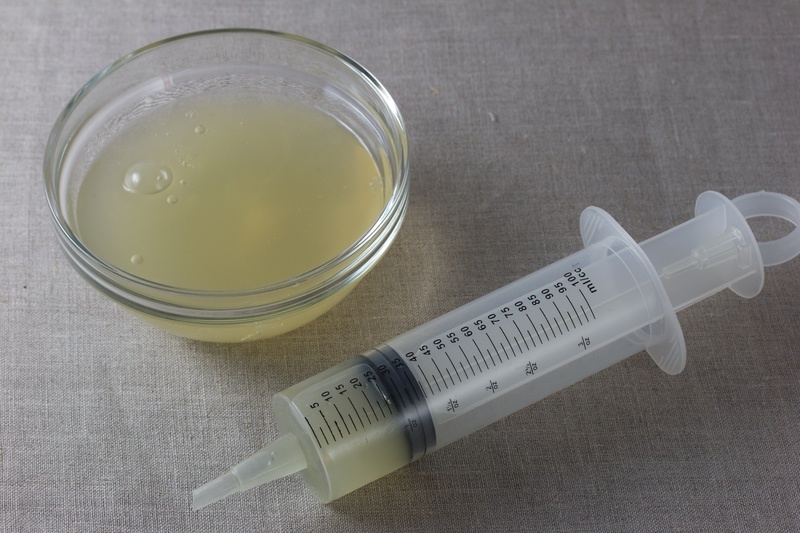



Measuring Flax Gel
Flax gel is a very powerful egg replacer but it can be difficult to measure out due to its extremely high viscosity and elasticity. It’s almost as if someone’s playing a trick on you when you need to measure it. Using Tablespoons, teaspoons and even transferring it to a container to weigh it is nearly impossible because it seems to want to go everywhere except where you want it to go. By far the best way to work with flax gel is with a $10 food grade syringe. By using a syringe it’s effortless to measure out a 3 Tablespoons, the amount that replaces one egg, when you note that 3 Tablespoons equals about 45 mL. You simply dip the tip into the flax gel mixture, pull the top of the syringe to draw the mixture inside of it to the desired measurement, transfer the syringe to where you’re dispensing it and push the mixture out. After using a food syringe for this purpose, I discovered that it works so well for transferring liquids that I ended up discarding my baster because it worked so much better. If you're into making sauerkraut you're going to love how easy it is to use one of these to draw off excess liquid.
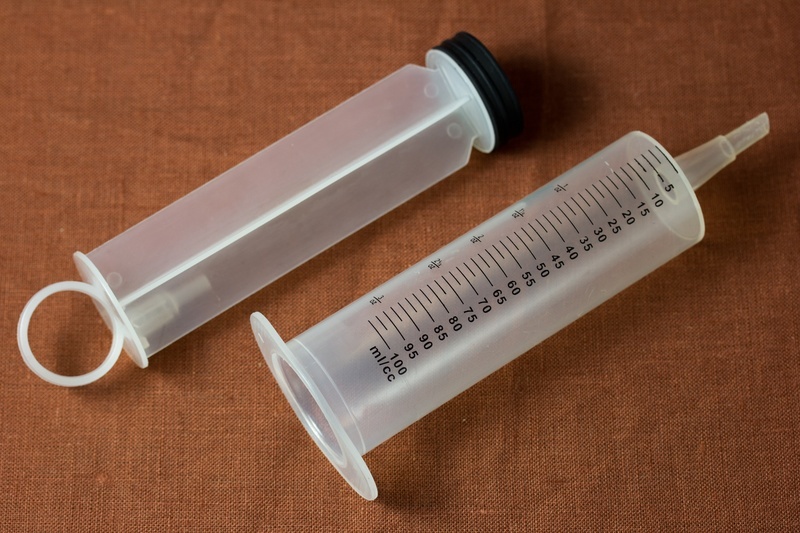

Not into remembering conversions and doing math? Me too. To easily convert Tablespoons and teaspoons to milliliters, check out the Baking Measuring Unit Converter.



